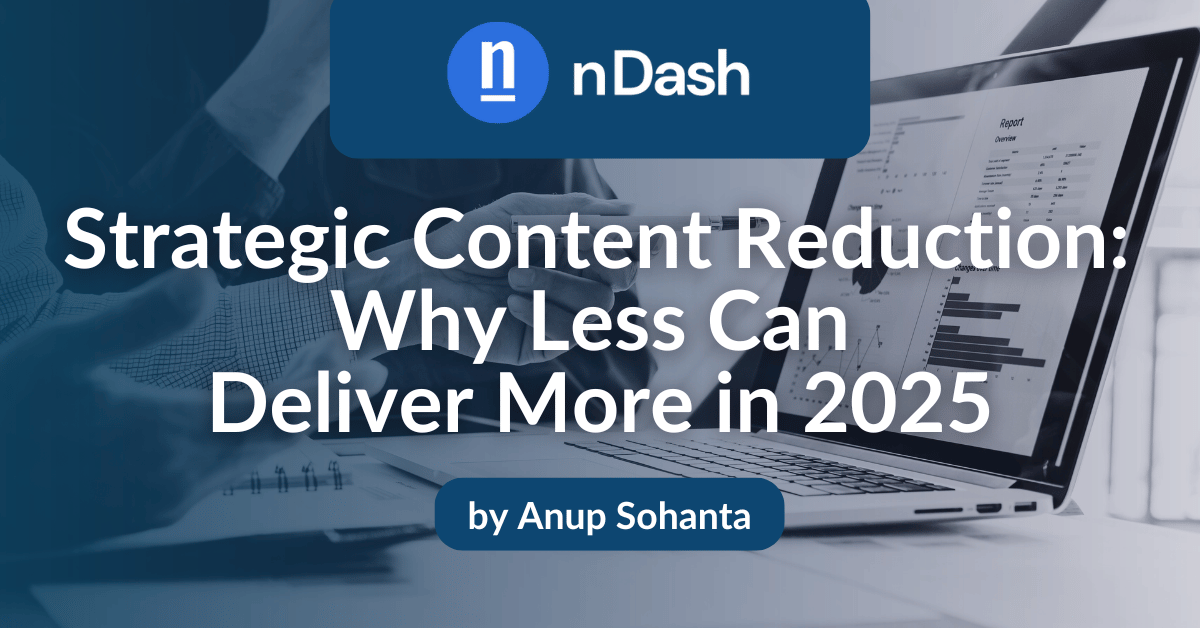The internet is becoming saturated with content, to the point where it is diluting brand messaging. Social media is flooded with regurgitated information; so are blogs and podcasts.
According to marketing guru Neil Patel, unique content consistently outshines rehashed content. Audiences want unique perspectives, fresh insights, and authentic points of view.
In this post, you’ll learn about strategic reduction and why it should be a part of your content marketing strategy.
Content and Marketing Myths
Firstly, it’s important to clear up a few content marketing misconceptions:
- More content is better: More content means more touchpoints and opportunities for engagement, right? Unfortunately not. Increasing content without enhancing value can be detrimental to both SEO and your brand. Google’s changes to search state that low-quality content will appear 40% less in SERPs.
- More content reinforces your messaging: Increasing content output is generally beneficial for your brand’s messaging, but this is not always the case. Brands often chase trends and fixate on SEO content to drive engagement. However, a major drawback is diluting your overall brand messaging by deviating from brand identity and core values.
- You’ll make it once you go viral: Short viral spikes can be fleeting, and their unpredictability makes them unsustainable in the long term.
The Case for Strategic Reduction in Content Marketing
According to Orbit Media, a meager 20% of bloggers now report seeing “strong results,” a decline from 30% just five years ago. Driving traffic and keeping audiences engaged with content are the biggest challenges.
Strategic reduction systematically reduces and streamlines content to meet audience needs, rather than fulfilling quotas. Why? Audiences want to connect to brands without feeling fatigued by regurgitated content.
Brands often follow trends for short-term visibility and engagement boosts, but these trends are fleeting. Strategic reduction focuses on content with a purpose. Evergreen content, with topics that remain relevant, can generate consistent long-term traffic.
Key Insights for Your Content Marketing Strategy
Audience-first content strategically focuses on your audience’s needs and how to deliver high-quality content effectively. There are several key points to consider when developing your next content marketing strategy.
Conduct a Content Audit
Old and underperforming content can damage your brand’s messaging, and maintenance can be costly. A content audit is akin to a wellness check, evaluating the health and performance of content across your digital touchpoints. Content audits help identify if outdated content needs revision and if a shift in direction is necessary. Regular content audits help discover KPIs such as your search rankings, engagement, and conversions.
Set Performance Benchmarks
Creating performance benchmarks is crucial for measuring the success of your content. Consider these points when effectively setting performance benchmarks:
- Define your content goals and align them with your business objectives and benchmarks. For example, do you want to increase traffic or improve SEO? It’s important to understand what success looks like for your content marketing efforts.
- Consider which KPIs you will track, such as traffic (e.g., unique visitors, email sign-ups), or the level of brand awareness you will generate.
- Establish baselines with tools like SEMrush and Google Analytics to gather performance data. For example, average engagement rates and comparing top-performing content to underperforming content.
Archive or Repurpose Underperforming Content
When reducing blog content, archive old content that no longer aligns with your brand or current offerings. Is the content stale? It can still be repurposed if the topics are relevant or have underutilized potential. You can reuse old content by combining low-value posts into a single, longer post or incorporating parts into top-performing posts.
Pivot to High-Value Pieces and Unique POVs
Data from Spout Social shows that 77% of consumers are likely to engage with relatable and authentic content. For example, content highlighting unique points of view, such as thought leadership pieces and user-generated content (UGC).
Be Real, Be Human, Connect With Your Audience
The ultimate goal is to connect with your audience and provide them value. Everything after that is built on establishing trust. Strategic reduction removes underperforming content, highlighting the need for purpose-driven content. A content calendar that isn’t fixated on churning out content to keep your brand relevant. Instead, it’s the content your audience wants to read, listen to, and view.

About the author:
Anup Sohanta is a freelance writer and poet who specializes in developing content and content strategies across multiple channels to drive engagement and positive growth. Check out his profile to learn more about what he can do for you today!
